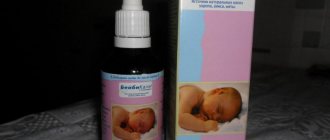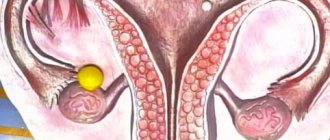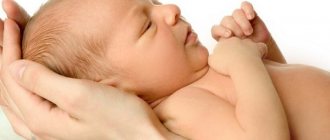- June 22, 2018
- Pediatrics
- Galina Chebykina
The birth of a long-awaited baby is a bright and joyful event. But, unfortunately, childbirth does not always end one hundred percent well; sometimes complications arise. The most common occurrence, according to experts, is asphyxia of newborns, the degrees of which vary. According to doctors, it occurs in 4-6% of births. The causes and consequences of asphyxia in newborns are different. Today’s article is intended to familiarize parents, or future parents, with the very definition of “asphyxia,” why it can occur, and what complications subsequently appear in the baby.
What is newborn asphyxia
From Latin, “asphyxia” is translated as lack of oxygen, that is, suffocation. Asphyxia of newborns is a pathological condition in which gas exchange in the body is disrupted, insufficient oxygen enters the blood due to obstructed breathing, carbon dioxide accumulates, and it poisons all tissues of the baby’s organs.
A child born with signs of asphyxia cannot breathe independently after birth for a minute or a longer time, or he exhibits convulsive, convulsive, unstable breathing with a preserved heartbeat. Babies need urgent resuscitation for asphyxia. The consequences depend on the degree of the complication, the cause of its occurrence and the quality of medical care provided.
Treatment of asphyxia in newborns
Emergency (first) aid for asphyxia of newborns
First aid for asphyxia in a newborn involves the following steps:
- The child is placed under a heat source;
- dry the skin;
- tactile stimulation is carried out on the back, sole of the foot;
- put the child on his back, tilt his head back a little;
- cleanse the mouth and nasopharynx of contents;
- amniotic fluid is sucked out of the respiratory tract using an endotracheal tube;
- if breathing is insufficient or completely absent, mechanical ventilation is started;
- during prolonged ventilation of the lungs, a probe is inserted into the stomach, through which the gas accumulating in it is sucked out.
All the above steps are carried out quickly for 2-3 minutes, periodically recording vital signs. If after the manipulations the heartbeat reaches 100 beats/min, spontaneous breathing appears, and the skin acquires a pinkish tint, artificial ventilation is stopped. If the child's condition does not improve, further resuscitation is continued.
Resuscitation of newborns with asphyxia
Resuscitation is continued with indirect cardiac massage, which is carried out for 30 s. If heart rate remains at 60-80 beats/min. or absent altogether, resort to medication.
- Adrenalin
An adrenaline solution is administered intravenously at a dosage of up to 0.3 ml/kg. It strengthens heart contractions, increases its blood supply, increases blood pressure, and has a bronchodilator effect.
If within 30 seconds after the administration of adrenaline the heartbeat does not accelerate above 80 beats/min, repeat again.
- Infusion therapy.
In cases where there is no effect from the measures taken, blood volume replenishers are used - solutions of albumin, sodium chloride - at the rate of 10 ml/kg intravenously for 5 minutes.
In combination with other resuscitation measures, the administration of blood replenishing drugs improves blood circulation, increases blood pressure and heart rate.
If the measures taken are ineffective, intravenous administration of a 4% sodium bicarbonate solution at a dosage of 4 ml/kg is indicated.
If necessary, pulmonary ventilation and fluid therapy are continued as part of post-resuscitation intensive care.
Classification of infant asphyxia
There are two forms of asphyxia based on the time of its occurrence:
- primary, arising during childbirth;
- secondary, manifesting itself several hours or days after birth.
The causes of complications in both cases are different; we will consider them in the further content of the publication.
Asphyxia is also classified according to severity, which is determined by the Apgar score in the first minutes after birth:
- Mild - the child begins to breathe independently in the first minute, he is active and reacts to stimuli, there is slight blueness in the mouth and nose.
- Average - the child takes a breath on his own in the first minute of life, is weakened, there is blueness in the nose, lips, hands and heels, reacts to irritants, sneezes and coughs.
- Severe - the baby can take his first breath in the first minute, or maybe not, then he needs an oxygen mask. The child is severely weakened, the heartbeat is weak, the skin is pale, there is no reaction to stimuli.
- Clinical death - the baby is born without signs of life, severe blueness of the face and limbs is noted. If resuscitation within 20 minutes does not produce results, then assistance is stopped.
The consequences of asphyxia during childbirth, or in the future, will be described below.
Clinical picture
The main signs of newborn asphyxia are respiratory disorders, which ultimately lead to dysfunction of the cardiovascular system, muscle tone and reflexes of the child.
Moderate asphyxia
With moderate asphyxia, the condition of the newborn at birth is usually of moderate severity. Already from the first minutes of life, he has spontaneous motor activity, however, the baby is most often lethargic, and reflexes and reactions to examination and stimuli are weakened. The cry is unemotional and weak.
The skin is bluish, but with additional oxygenation (for example, artificial ventilation using a mask or bag), they quickly turn pink. However, acrocyanosis often remains (bluish coloration is expressed in areas of the body most distant from the heart: on the fingers and toes, the nasolabial triangle, and the ears).
After initial care in the delivery room, babies usually require supplemental oxygen - through nasal prongs, an oxygen tent or a mask. When listening to the heart, a rapid heartbeat is detected, heart sounds are often muffled. After a prolonged initial cessation of breathing, it is rhythmic, with groans or sighs, swelling of the wings of the nose and retraction of the intercostal spaces are possible. Repeated short-term apneas (cessation of respiratory activity) are also characteristic. Auscultation (when listening with a phonendoscope) weakened breathing and moist rales of varying localization and sonority are detected over the lungs.
The condition of children who suffered moderate asphyxia at birth, if timely and adequate therapy is carried out, improves quite quickly and becomes satisfactory by approximately the fourth or fifth day of the child’s life.
Severe newborn asphyxia
In case of severe primary asphyxia, the condition of the newborn immediately after birth is accordingly assessed as severe or very severe. Motor activity, muscle tone, response to examination and tactile stimulation are significantly reduced or completely absent. Physiological reflexes are usually not evoked in such a child in the first hours of life. The skin color is pale or bluish (the so-called diffuse cyanosis) and is restored to pink very slowly even with active oxygenation, most often artificial pulmonary ventilation (ALV). This indicates severe oxygen debt, severe metabolic disorders and microcirculation disorders. In this case, heart sounds are muffled or dull, and when listening over the heart area, a systolic murmur may be detected.
If the child is in a very serious condition at birth, the clinical picture corresponds to the so-called hypoxic shock. The skin in this case is pale or with an earthy tint. Blood pressure is critically low. As a rule, there is no spontaneous breathing. There is no reaction to examination or painful stimuli; there is a complete absence of muscle tone and reflexes. The eyes are closed, and the reaction to light from the pupils is weak or completely absent. Heart sounds are muffled, bradycardia (rare heartbeat) is detected. Severe arterial hypotension (very low blood pressure) is also characteristic.
As a result of correct and timely resuscitation actions, when spontaneous respiratory activity appears, there is a pronounced participation of the auxiliary respiratory muscles, retraction of the sternum and intercostal spaces. Respiratory movements are usually arrhythmic, and attacks of apnea are often observed. Moist rales are heard above the lungs against the background of weakened breathing.
The further neurological picture in these children is as follows: within a few hours after birth or in the second half of the first 24 hours of life, they may develop signs of increased excitability, bulging of the large fontanelle, while pronounced muscle hypotonia persists, as well as the absence of a sucking reflex and often even independent breathing. This condition lasts 1 - 2 days, after which the manifestations of stupor intensify again, possibly as a result of the occurrence of intracranial hemorrhages, metabolic disorders and other disorders. With a favorable course, from the 2nd to 3rd day of the child’s life, signs of stabilization of the circulatory system, spontaneous breathing, physiological and tendon reflexes gradually begin to appear.
It must be remembered that newborns who were born with asphyxia or suffered chronic intrauterine hypoxia are characterized by certain features. Such children, as a rule, have a tendency to develop pulmonary lesions more frequently; they also have a high percentage of birth injuries and a high prevalence of long-term consequences (encephalopathy of varying degrees and severity).
Factors influencing the occurrence of asphyxia
The described pathology is not an independent illness, but only a consequence of complications during pregnancy, the state of health of the mother or fetus.
Fetal factors influencing the occurrence of asphyxia:
- intracranial injury to the baby received during childbirth;
- Rh conflict during pregnancy;
- abnormal development of the bronchopulmonary system;
- intrauterine infection;
- pathology of fetal growth development;
- early birth;
- aspiration asphyxia, that is, the baby’s airways are clogged with mucus and amniotic fluid;
- congenital heart failure of the fetus, a malformation of the baby’s brain.
Mother's factors
A healthy mother means her future baby is healthy. What pathologies of a woman can cause asphyxia in a baby?
- gestosis, manifested in the third trimester;
- diseases of the heart, blood vessels or lungs;
- anemia during pregnancy;
- birth shock;
- blood diseases, thyroid gland, diabetes mellitus, ovarian dysfunction;
- poor ecology in the place of residence;
- bad habits during pregnancy (smoking, drinking alcohol and drugs);
- poor or insufficient nutrition (if the expectant mother is a vegetarian, she will have to give up her beliefs for nine months and start eating meat and dairy products (at least in small quantities), which are necessary for the full development of the fetus);
- infections suffered during pregnancy;
- treatment with drugs prohibited during pregnancy.
About prevention
The expectant mother will be able to prevent the development of asphyxia in the baby if she follows the following recommendations from experts:
- Plan a pregnancy. Even before conception, undergo a comprehensive medical examination and treat all identified pathologies.
- Eat nutritiously and rationally while expecting a baby.
- Take special vitamin and mineral complexes for expectant mothers.
- Do gymnastics for pregnant women, regularly take walks in the fresh air and avoid psycho-emotional shocks.
Regular visits by the expectant mother to a gynecologist, routine ultrasound examinations and laboratory tests are of great importance in the prevention of asphyxia in newborns. Timely diagnosis will make it possible to identify and treat possible complications during pregnancy, fraught with subsequent asphyxia (such as gestosis, hypoxia, placental insufficiency, etc.).
Please note : according to statistics, measures to prevent asphyxia in newborns give positive results in 40% of cases!
Asphyxia in newborns is a dangerous condition, fraught with complete depression of respiratory function and the development of severe complications . At the first signs characteristic of this pathology, the baby needs urgent help from resuscitators! Subsequent treatment is aimed at preventing possible complications and is determined on an individual basis. The causes of asphyxia are very diverse, however, pregnancy planning and strict adherence by the expectant mother to the specialist’s recommendations will reduce possible risks to a minimum!
Betsik Yulia, obstetrician-gynecologist
7, total, today
( 197 votes, average: 4.57 out of 5)
Can a baby have milk?
Paint vapor poisoning: symptoms, first aid, treatment and consequences
Related Posts
Factors of the uteroplacental circle
But not always the pathological condition of the mother or fetus can cause asphyxia. There are factors that appear during pregnancy for which neither the baby’s parents nor doctors are to blame.
- early placental abruption;
- rapid aging of the placenta;
- post-term fetus;
- repeated entanglement of the fetal neck with the umbilical cord, false and true knots;
- placenta previa;
- pregnancy in which several fetuses develop, that is, multiple pregnancy;
- lack/excess of amniotic fluid;
- incoordination during childbirth; weakness of the flow; rapid labor;
- uterine rupture;
- general anesthesia for the woman in labor;
- C-section.
Causes of the disease
Asphyxia is not considered an independent disease; it is only a manifestation of various types of complications of pregnancy, childbirth, diseases of the woman or the fetus itself. All possible reasons are divided into several groups:
- Fruit factors;
- Maternal factors;
- Disorders of intrauterine development;
- Diseases of the newborn causing secondary asphyxia.
Each group is divided into several more reasons, so let’s try to figure them out together. So let's begin.
Fruit factors:
- Traumatic brain injuries received by a child during childbirth;
- Differences in Rh factors of mother and child;
- Abnormal development of the fetal bronchopulmonary system;
- Infections acquired by the fetus during the prenatal period;
- Prematurity;
- The fetus grew poorly in the prenatal period;
- During childbirth, the baby's airway becomes blocked by natural fluids or the umbilical cord;
- The fetus was found to have malformations of the brain and heart.
Maternal factors:
- During pregnancy, a woman had high blood pressure against the background of pronounced edema;
- The pregnant woman suffered from heart and lung diseases;
- Severe anemia;
- Endocrine diseases;
- The birth process came as a shock to the woman;
- Ecological problems;
- Abuse of bad habits;
- The expectant mother did not eat enough or nutritiously during pregnancy. Usually these are women obsessed with their figure and always on a strict diet;
- During pregnancy, a woman uses medications that are prohibited during this period;
- A woman suffered from infectious diseases during pregnancy.
Developmental disorders in the prenatal period:
- Pregnancy is post-term;
- Aging of the placenta occurred ahead of schedule;
- The placenta separated earlier;
- Pathology of the umbilical cord, knots have formed on it (false and true) or it has become entwined around the fetus;
- Threat of miscarriage;
- Bleeding of the placenta;
- Pregnancy with a large number of fetuses;
- Lack or excess of amniotic fluid;
- Administration of narcotic drugs less than 4 hours before the end of labor;
- Childbirth is carried out under general anesthesia;
- The woman had a caesarean section;
- A uterine rupture occurred.
Causes of secondary asphyxia:
- Due to damage to the brain and lungs during childbirth, the baby's cerebral circulation is disrupted;
- Heart defects that could not be detected in a timely manner or they appeared a little later;
- The newborn’s stomach was poorly cleared of the contents, or milk or formula coagulated in his stomach;
- Lung pathologies.
Factors provoking secondary asphyxia
The consequences of newborn asphyxia are different, depending on the causes of the complication. Choking does not always appear during childbirth; it can begin in a baby even a few days after birth, which is why the baby should not be left unattended for a long time.
- impaired blood circulation in the brain due to damage to the skull or lungs during childbirth;
- undetected or undetected malformations of the baby’s heart in utero or during childbirth;
- poor-quality cleansing of the respiratory tract and stomach after birth;
- aspiration of the respiratory tract with milk, vomit;
- pneumopathy;
- edematous-hemorrhagic syndrome;
- the presence of atelectasis in the lungs;
- presence of hyaline membranes;
- hemorrhages in the lungs.
Babies need emergency medical care if birth asphyxia is detected. Consequences can be prevented in the future and minimized if doctors from the first minutes do everything to stabilize the baby’s condition. Complications can be either early or late. The consequences of asphyxia in newborns at older ages are observed less frequently than at earlier ages. We invite you to familiarize yourself with all the ailments that parents and doctors may have to face.
Causes of suffocation in children
Asphyxia is suffocation caused by compression of the respiratory tract, closing of their lumen with mucus, food, compression of the neck, chest and abdomen and leading to oxygen starvation and excessive accumulation of carbon dioxide in the tissues and cells of the body, which threatens severe disorders of the nervous system, breathing and circulation .
In a newborn, this condition can be caused mainly by two reasons:
- The presence of an external obstacle to free breathing : a diaper hung on the crib railing or a corner of a blanket may fall on the child’s face; The baby may burrow or “crawl” under the blanket when he sleeps restlessly or when he wakes up. It must be said that newborns have an unconditioned crawling reflex: the child lies on his stomach and if something hard gets under his feet (the side of a crib, changing table), then the baby is able to push off the object with his legs and make crawling movements, lifting and moving his buttocks forward . In this case, the head, shoulders and arms passively move along the surface. Getting tangled in the strings of a duvet cover, bumper, or rattles placed low on the crib can also cause suffocation. Long laces from bonnets, pacifiers, and jewelry chains can wrap around a child’s neck, causing suffocation, which is complicated by the baby’s efforts to free himself from them. Sleeping together in the same bed between the baby and parents, and even more so - sleeping together in the same bed with older brothers and sisters is also dangerous due to possible suffocation of the newborn. They may accidentally cover his head and press the baby's face to his body. It is also dangerous to put your baby to sleep on a bed with a hydromattress. The baby may find itself between its fixed parts and the movable mattress. You should not trust older children too much to care for your newborn. They may be too zealous in caring for the younger one: wrapping him up too much, covering him with a blanket, or feeding the child food that is inappropriate for his age, for example, sharing cookies with him, especially if the baby is crying.
- The entry of foreign bodies into the respiratory tract (most often these are food masses during regurgitation or vomiting) is the cause of accidents. This is especially dangerous for premature, weakened children, in whom all protective reflexes are not yet sufficiently developed. In such babies, breathing may stop during sleep, without the appearance of a characteristic cough as a defensive reaction when the body tries to free itself from a foreign body.
Asphyxia during childbirth: consequences in the future
Lack of oxygen in the baby's blood during pregnancy or after birth almost always leads to complications. Asphyxia leaves its mark on all vital organs, which can occur at any time. But parents should not worry too much if the Apgar score in the first five minutes of the baby’s life has increased; in this case, the bad consequences of newborn asphyxia are practically not noted, and the baby is given a favorable prognosis. Side effects depend on the emergency care provided, further treatment, and the severity of asphyxia.
Consequences of newborn asphyxia depending on the degree
How will a child develop after suffering hypoxic encephalotherapy due to neonatal asphyxia? The frequency of complications, according to experts, depends on the following:
- first degree of encephalotopia after asphyxia: the baby’s development is no different from the development of healthy babies, the consequences of newborn asphyxia are not noted;
- with the second degree of hepoxic encephalotopia, from 25 to 30% of children subsequently suffer from mild neurological disorders;
- in the third degree, about half of the babies do not survive during the first week of life, the rest, in 75-100% of cases, suffer from severe neurological disorders with increased muscle tone and cramps, then delayed physical and mental development.
The consequences of severe asphyxia of newborns are almost inevitable, but such a complication is extremely rare.
Early complications
Doctors note early effects in the first 24 hours of a baby’s life, these include:
- cerebral hemorrhage or swelling;
- convulsions;
- increased intracranial pressure, small and large hand tremors;
- respiratory arrest;
- pulmonary hypertension;
- increase in the number of red blood cells;
- thrombosis, decreased blood clotting;
- hypoglycemia;
- posthypoxic cardiopathy, irregular heart rhythm;
- disorders in the urinary system;
- gastric and intestinal disorders (digestive tract dysfunction, intestinal paresis and enterocolitis).
Late complications
The consequences of asphyxia in newborns at an older age - from three days of life and later, are manifested in the following:
- hyperexcitability (increased excitability at any age, tachycardia);
- decreased excitability (lethargy, tendency to lethargy, decreased muscle tone, adynamism, low pulse, decreased and sometimes sluggish breathing;
- convulsions;
- hypertensive-hydrocephalic syndrome, in which there are convulsions, strabismus is often noted;
- vegetative-visceral syndrome;
- movement disorders;
- sepsis;
- development of meningitis;
- development of pneumonia;
- late speech development;
- educational lag;
- weak immunity.
In conclusion, I would like to note that this article describes the most serious consequences of newborn asphyxia. In most cases, with proper therapy, complications can be eliminated.










